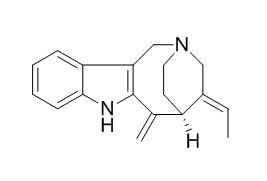Apparicine
Standard reference
Inquire / Order:
manager@chemfaces.com
Technical Inquiries:
service@chemfaces.com
Tel:
+86-27-84237783
Fax:
+86-27-84254680
Address:
1 Building, No. 83, CheCheng Rd., Wuhan Economic and Technological Development Zone, Wuhan, Hubei 430056, PRC
Providing storage is as stated on the product vial and the vial is kept tightly sealed, the product can be stored for up to
24 months(2-8C).
Wherever possible, you should prepare and use solutions on the same day. However, if you need to make up stock solutions in advance, we recommend that you store the solution as aliquots in tightly sealed vials at -20C. Generally, these will be useable for up to two weeks. Before use, and prior to opening the vial we recommend that you allow your product to equilibrate to room temperature for at least 1 hour.
Need more advice on solubility, usage and handling? Please email to: service@chemfaces.com
The packaging of the product may have turned upside down during transportation, resulting in the natural compounds adhering to the neck or cap of the vial. take the vial out of its packaging and gently shake to let the compounds fall to the bottom of the vial. for liquid products, centrifuge at 200-500 RPM to gather the liquid at the bottom of the vial. try to avoid loss or contamination during handling.
Food Funct.2021, 12(4):1469-1481.
International J of Green Pharmacy2019, 13(3)
J Appl Toxicol.2024, jat.4615.
Pharmaceuticals (Basel).2024, 17(4):442.
Agronomy2023, 13(9), 2410.
Prev Nutr Food Sci.2024, 29(4):504-511.
Current Enzyme Inhibition2023, 19(1):55-64(10)
J Cachexia Sarcopenia Muscle.2022, 13(6):3149-3162.
J Biol Chem.2021, 297(6):101362.
Life (Basel).2022, 12(10):1630.
Related and Featured Products
Malar J. 2014 Apr 14;13:142.
Anti-malarial activity of indole alkaloids isolated from Aspidosperma olivaceum.[Pubmed:
24731256 ]
Several species of Aspidosperma (Apocynaceae) are used as treatments for human diseases in the tropics.
METHODS AND RESULTS:
Aspidosperma olivaceum, which is used to treat fevers in some regions of Brazil, contains the monoterpenoid indole alkaloids (MIAs) aspidoscarpine, uleine, Apparicine, and N-methyl-tetrahydrolivacine. Using bio-guided fractionation and cytotoxicity testing in a human hepatoma cell line, several plant fractions and compounds purified from the bark and leaves of the plant were characterized for specific therapeutic activity (and selectivity index, SI) in vitro against the blood forms of Plasmodium falciparum.
J Org Chem. 2014 Jul 3;79(13):6389-93.
Convergent approach to the tetracyclic core of the apparicine class of indole alkaloids via a key intermolecular nitrosoalkene conjugate addition.[Pubmed:
24927230]
METHODS AND RESULTS:
Readily available methyl 3-formylindol-2-ylacetate and N-tosyl-4-chloro-3-piperidone oxime have been used to construct the tetracyclic skeleton of the Apparicine class of monoterpene indole alkaloids in only four steps in 80% overall yield.
CONCLUSIONS:
Key transformations in this convergent approach involve use of an intermolecular ester enolate/nitrosoalkene conjugate addition to form the C-15/16 bond, followed by a reductive cyclization to construct the C-ring of the tetracycle.
J Org Chem. 2009 Nov 6;74(21):8359-68.
Total synthesis of the bridged indole alkaloid apparicine.[Pubmed:
19824689]
METHODS AND RESULTS:
An indole-templated ring-closing metathesis or a 2-indolylacyl radical cyclization constitute the central steps of two alternative approaches developed to assemble the tricyclic ABC substructure of the indole alkaloid Apparicine. From this key intermediate, an intramolecular vinyl halide Heck reaction accomplished the closure of the strained 1-azabicyclo[4.2.2]decane framework of the alkaloid with concomitant incorporation of the exocyclic alkylidene substituents.



